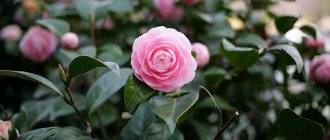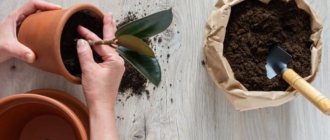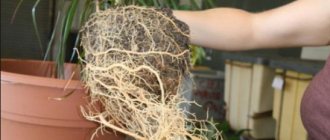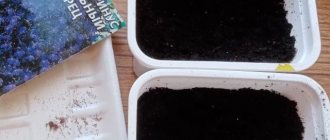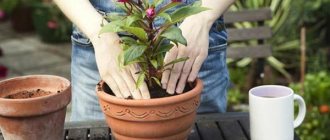For normal development, many flowers will require transplantation in April 2022, which is best done according to the lunar calendar.
Dear readers! For you, we have created communities on social networks in which useful articles and interesting ideas are published several times a day! Subscribe and receive useful content in a convenient format!
They take a lot of nutrients from the soil and spend them on the formation of buds and the growth of green mass. But over time, the soil becomes depleted, and even timely fertilizing does not provide everything the plants need.
Therefore, it is important to regularly replant crops into a new substrate and do this according to the rules of the lunar calendar.
How to understand that flowers need replanting
Young specimens are recommended to be replanted every year. For adult plants, this procedure is required once every 2-4 years. And you can understand that crops require planned replanting based on the following signs:
- The flower has slowed down in growth and development, does not produce buds and forms small leaves.
- The earthen ball is completely entangled in roots, and the shoots protrude from the drainage hole.
- Water is slowly absorbed into the ground after watering. Or vice versa, the soil dries out quickly after irrigation.
It is also necessary to replant if the soil is moldy and emits an unpleasant odor. This suggests that due to excessive watering, the roots of the flower have rotted. And if the substrate is not urgently updated, the culture will quickly die.
Flower growers' work in the open ground in April
In April, crocuses, marigolds, and blueberries begin to emerge from under last year's grass. Tulips also begin to actively grow, forming their future buds. In order for their stems to be long and the glasses to be large, you need to add nutrient mixtures for bulbous plants containing nitrogen, loosen the soil and water it.
Remove the foliage with which perennial specimens were mulched so that the flowers feel the warmth of spring. When the soil warms up, it can again be covered with mulch so that it does not dry out under the sun's rays.
Care and planting of new roses
We gradually open the roses, remove the spruce branches and foliage from them, but for now we return the covering material. Over the winter, flowers have become unaccustomed to sunlight and wind, which can destroy them. If there is a shelter, open it on the side for ventilation. When the soil warms up, the roots gain strength, and the cover can be removed.
Removing cover. Trimming.
Hybrid tea, polyanthus and floribunda roses need to be pruned back to wood. For park varieties, this only needs to be done for the frozen ends.
At the beginning of the month, you can plant roses; you need to trim their shoots so that the nutrients do not go to the above-ground part, without reaching the root system. If this is not done, the flowers may die.
Care and planting of perennial flower variety
It is necessary to cover with non-woven material specimens that overwinter with green leaves (filamentous yuccas, holly mahonias and others). It is necessary to protect the needles of spruce, juniper, and thuja from the sun.
Division, transplantation and planting
When perennial specimens grow (asters, sedums, chrysanthemums, etc.), you need to see which of them need dividing and replanting. This does not apply to varieties that bloom in spring and June. Work on them is carried out in the fall.
It is advisable to divide and replant chrysanthemum bushes that are over 2 years old. If this is not done, many thin shoots will appear that will break under a gust of wind, without having time to bloom. There should be 1-2 strong shoots on the cuttings. They will grow quickly and produce buds in the same season.
Amaranth
You can plant gladioli tubers in open ground. Choose a site where these flowers have not been grown for several years. Before planting, clean the bulbs and treat them with insecticides. Old and sick ones (with a flat bottom) cannot be planted; they can be thrown away.
Planting gladioli
Pruning flowers and shrubs
In order for the delphinium to produce strong, tall stems and large inflorescences, weakened shoots need to be cut off. This should be done while they are only 5-8 cm high. It is necessary to leave only 2-3 strong stems, and cut the rest at the very root collar, place them in growth stimulants and plant them in cuttings for rooting. Cover with a 5 cm layer of sand on top.
Delphinium
In April, you can still prune ornamental shrubs, which are attractive not because of their flowers, but because of the bright, variegated color of their leaves, in order to stimulate the active growth of young shoots. Of course, it would have been better to do this in March, before the sap flow began. At the same time, their leaves achieve the maximum decorative effect, and the bushes retain a neat shape.
Planting and sowing annuals in the ground
In April it is already possible to plant annuals (tagetes, zinnias, petunias, amaranth and others). This should be done under film cover. On warm days, the film should be opened for ventilation.
Attention! Humus should not be added to the soil so as not to provoke the development of blackleg disease.
Annual asters are grown either by seedlings or by direct sowing in the ground. Seeds for seedlings, if they have not already been planted in March, should be sown in early April.
During germination, the seedlings are afraid of the soil drying out. With the appearance of the true leaf, the seedlings dive into a separate container. Aster seedlings love transplants. The more often this is done (for example, in the same pot, slightly stirring up the root system), the more abundantly it blooms. During flowering, aster is also not afraid of transplantation.
If you sow asters in March, there is a chance to collect mature seeds.
Annual asters can be sown in the ground in April, after the soil has thawed. You just need to choose varieties that are resistant to various diseases.
Read about aster varieties in the article Aster flower: types, varieties, planting and care in open ground.
The surface of the crops is sprinkled with calcined sand to protect the seedlings from blackleg.
Of course, asters sown directly outside will bloom later than seedlings. But they will delight you with flowers in the fall; the bushes will be more luxuriant and more resistant to infections. Annual specimens that are resistant to cold (Eschscholzia, cornflowers, Iberis, scabiosa, chrysanthemum, etc.) can be immediately planted in a permanent place and not covered with anything.
Lunar calendar of flower transplantation by day for April 2022, table
April is considered the best time to replant most house flowers. But during this month, plants also need other procedures that should be carried out on favorable days according to the lunar calendar.
| Procedure | Favorable days |
| Transplantation and planting | 13-15, 17-20, 24, 25 April |
| Watering and warm shower (the latter procedure is contraindicated for violets and plants with fluffy leaves) | April 1-5, 8-11, 13, 14, 18, 19, 23-26, 28-30 |
| Fertilizing (cannot be done if the plant has been replanted) | April 1, 2, 5, 8-11, 13-22, 23-26, 28-30 |
Lunar sowing calendar for gardeners and gardeners
♉♊
15 , Thursday. 4th, 5th lunar day from 06:44. TAURUS
,
GEMINI from 09:35
Moon without course from 03:00 to 09:34
After 09:35
It’s good to take care of the flower garden.
You can divide and plant perennials
, including
chrysanthemums, bells, phlox, hosts, pyrethrums
and others.
You can plant bulbous plants, such as gladioli and dahlias
, but it all depends on the readiness of the soil in your area. The soil temperature should be at least +10 ºС at a depth of 10 cm.
Houseplants
: after 09:35 you can start sowing beautiful flowering indoor plants if you want to try propagating them from seeds. You can also take bulbs out of storage and plant them in containers with soil.
What is better not to do
: plant leafy vegetables; trim fruit trees and berry bushes.
Watering
: It’s better not to water the plants today.
♊
16 , Friday. 5th, 6th lunar day from 07:03. GEMINI
You can plant flowers as seedlings, in a greenhouse or in the ground, it all depends on the type of plant and your weather conditions. This is also a good day to pick flowers.
medicinal plants, weather permitting.
For example, you can collect coltsfoot flowers.
Houseplants
: Sowing indoor plants is allowed. It is better to start all work before 18:00, before the Moon goes into idle mode. If you want to learn how to grow plants this way, you should start with less demanding ones that can be easily grown from seeds.
What is better not to do
: plant leafy vegetables; trim fruit trees and berry bushes.
Watering
: It’s better not to water the plants today.
© Sinlapachai Jaijumpa's Images
♊♋
APRIL 17, Saturday. 6th, 7th lunar day from 07:30. GEMINI
,
CANCER from 22:25
Moon without course from 18:03 to 22:25
It is worth caring for the seedlings and gradually accustoming the plants to the open air. For example, ventilate rooms
where the plants are located, leave them on an open balcony during the day, etc.
Houseplants
: Sowing indoor plants is allowed.
You can easily grow plants such as adeniums, cyclamens, plumerias, pelargoniums
and others.
What is better not to do
: plant leafy vegetables; trim fruit trees and berry bushes.
Watering
: It’s better not to water the plants today.
♋
APRIL 18, Sunday. 7th, 8th lunar day from 08:09. CANCER
A good time to sow cold-resistant greens, including dill, parsley, spinach, salads
.
This is also an excellent time for sowing peas
, which will bear fruit in the first half of summer.
If you sow peas in May, they will produce less fruit. Spinach can be planted as a cover crop
in greenhouses or outdoors.
You can collect buds, leaves and needles of medicinal plants ( birch, pine, lingonberry, bearberry
and others).
Houseplants
: today and tomorrow are good times for sowing greenery on the windowsill. For growing, it is worth choosing good lighting and monitoring the humidity in the premises.
What is better not to do
: plant root crops; trim fruit trees and berry bushes; do pinching.
Watering
: good time for watering. Use soft, settled water, or rainwater if you have the opportunity to collect it.
© Getty Images
♋ APRIL 19
, Monday. 8th, 9th lunar day from 09:02. CANCER
You can sow asparagus
for seedlings.
Before planting seeds in the ground, it is better to soak them for several days in warm water and maintain its temperature on a radiator or in very warm rooms. The temperature for germination should not be lower than 25 ºС. The plants can be transplanted to a permanent location around mid-June
.
After planting, the shoots will only be suitable for food for 3-4 years
, so these plants are quite expensive and not very popular among ordinary summer residents.
Houseplants
: Another good day for planting greenery.
You can plant onions, watercress, lettuce, dill, parsley, spinach, basil, arugula
, etc.
What is better not to do
: plant root crops; trim fruit trees and berry bushes; do pinching.
Watering
: good day for watering, spraying and showering.
© Getty Images Pro
WALKING MOON from 09:58
♋♌
APRIL 20, Tuesday. 9th, 10th lunar day from 10:09. CANCER
,
LEO from 09:10
Moon without course from 03:03 to 09:09
First quarter, Second phase of the Moon from 09:58
Today the Moon is changing phase, which is not very favorable for various complex works. It is better to rest on this day and not start anything important.
Houseplants
: It is better not to deal with plants today, with the exception of watering.
What is better not to do
: engage in planting, pruning, grafting and other complex types of work (weak Moon); to go shopping.
Watering
: allowed if necessary, but a better time for watering is before 09:10.
♌ APRIL 21
, Wednesday. 10th, 11th lunar day from 11:26. LEO
Today you can start planting fruit trees
. You should choose young seedlings with a good root system, which are no more than 2 years old and whose buds have not yet opened. Or you can use seedlings with a closed root system.
Houseplants
: Today you can start planting fruit bushes.
For example, a lemon tree,
an avocado or pomegranate
bush , etc.
bananas
at home !
What is better not to do
: to go shopping.
Watering
: Allowed if necessary.
How moon signs affect flowers when transplanting
Transplanting flowers in April 2022 according to the lunar calendar will go better, taking into account the influence of the zodiac signs.
- Decorative foliage crops (Dieffenbachia, ficus, chlorophytum, dracaena). The best time according to the lunar calendar for a transplant will be the period of the waxing moon in the sign of Gemini, Scorpio, Libra or Pisces. The event can also be held during a waning night light. But only when it is in the sign of Cancer.
- Tuberous and bulbous plants (gloxinia, cyclamen, amaryllis, begonia). It is worth replanting such crops according to the lunar calendar during the waxing moon in the sign of Capricorn. When the night star wanes, it is better to start the event in the sign of Scorpio.
- Ampelous crops and lianas (campanula, scindapsus, hoya, aeschynanthus). Climbing plants according to the lunar calendar should be replanted on the waxing moon in Gemini. When the night star wanes, it is better to hold the event in the sign of Sagittarius or Virgo.
In any case, according to the lunar calendar, you cannot replant flowers on the New Moon and Full Moon. At this time, manipulation will only harm them.
REFERENCE. The lunar calendar influences the development of plants, and replanting and other manipulations with flowers should be carried out depending on the phase of the night star and what sign it is in.
House plant lunar calendar
♎
APRIL 25, Sunday. 14th, 15th lunar day from 17:20. SCALES
You can plant grafted roses
.
This is also a good time to divide perennials: chrysanthemums, delphiniums, phlox, daylilies
, etc.
You can sow heat-loving annual plants
, including
annual asters, purslane, cleomes, coleus
and others.
Houseplants
: today there are especially no recommendations for caring for plants, but in the evening, after 16:20, it is good to collect the necessary information and communicate with specialists or experienced gardeners on topics that interest you.
What is better not to do
: to go shopping.
Watering
: It’s better not to water the plants today.
♎ ♏
APRIL 26 15th, 16th lunar day from 18:55. LIBRA
,
SCORPIO from 19:19
Moon without course from 15:40 to 19:15
The full moon is approaching, so this day is not particularly suitable for planting. It is better today to read and collect information on topics that interest you regarding growing plants. You can pick flowers
medicinal plants.
Houseplants
: There are no special recommendations for caring for plants. From 14:00 to 15:40 you can make purchases. You should not make purchases during the Moon without a course!
What is better not to do
: sow the lawn; engage in planting, pruning, grafting and other complex types of work (weak Moon).
Watering
: watering is allowed after 19:20; it is better not to water the plants during the day.
© pixelshot
WANING MOON from 06:32
♏
APRIL 27 16th, 17th lunar day from 20:33. SCORPIO
FULL MOON at 06:32
Today is the full moon, the day is quite difficult, so try not to overwork yourself too much. It’s better to relax today and not do any difficult work.
. If necessary, you can get rid of pests.
Houseplants
: It is better not to deal with plants today, with the exception of watering.
What is better not to do
: engage in planting, pruning, grafting and other complex types of work (weak Moon); to go shopping.
Watering
: good day for watering and spraying. Remember that not all plants like to be sprayed.
♏ ♐
28 , Wednesday. 17th, 18th lunar day from 22:12. SCORPIO
,
SAGITTARIUS from 18:43
Moon without course from 15:31 to 18:42
Today you can get rid of pests, for example, you can shake insects from trees onto the litter early in the morning, when the air temperature is still no more than 10 ºС
. If you don't get on your property that often and can't do regular brushing, you may need to use chemicals.
Houseplants
: It’s good to do pest control or carry out preventative work on this day. It is useful to disinfect the surfaces of the window and window sill, wash the leaves well, and make sure that the air humidity in the room is normal. In very dry air, pests multiply faster.
What is better not to do
: plant potatoes.
Watering
: good time to water, especially before 6:45 p.m.
© Getty Images
♐
29 , Thursday. 18th, 19th lunar day from 23:46. SAGITTARIUS
By the end of the month you can start planting potato
.
If the weather is warm, then you should not wait until the tubers begin to sprout. In colder temperatures, it is worth covering the beds with film
.
It is better to avoid planting potatoes in the places where they grew last year, as well as next to tomatoes
.
Houseplants
: if the plants have become very elongated in recent months, some of them can be pinched and pruned to form a beautiful bush.
Ficuses, pelargoniums, tradescantia, various vines
and other plants may require pruning
What is better not to do
: plant flowers and medicinal herbs.
Watering
: Allowed if necessary.
♐
APRIL 30 19th lunar day. SAGITTARIUS
,
CAPRICORN from 19:17
Moon without course from 16:26 to 19:16
It is still good to control pests, apply fertilizers for vegetable crops and fruit trees and shrubs, as well as clean up and clean up the area
.
If weather conditions permit, you can harvest greens that have ripened by this time. After sunset, it is good to collect the roots and rhizomes
of medicinal plants (
elecampane, cinquefoil erect, male fern, knotweed
and others).
Houseplants
: This is a good time to tackle pests. Preventative spraying can also be carried out. Inspect your plants as often as possible to spot problems early. As you know, the sooner you start treatment for infection, the easier it will be to cope with pests.
What is better not to do
: plant flowers and medicinal herbs.
Watering
: Allowed if necessary.
© Getty Images Pro
Tips for caring for flowers in April 2022
Transplantation is a rather painful procedure for plants. And so that cultures can more easily tolerate it and quickly adapt, it is worth following the instructions during the event. And it is also necessary to prepare the pot and substrate for the flower in advance.
Preparation
For flowers, you need to prepare a new pot, the diameter of which should be 1-3 cm larger than the previous one. The flowerpot should be thoroughly washed with laundry soap and doused with boiling water. If other flowers grew in it before, then treatment with fungicides would be useful. This will prevent infection by fungi and bacteria.
You will also need to prepare soil suitable for a specific crop. More often, the “Universal” mixture is used for transplanting flowers. You can also buy a specialized substrate marked, for example, “For cacti”, “For violets”, “For azaleas”.
You can make the soil yourself. But for each flower crop it is necessary to make a mixture with a certain composition. For example, Saintpaulias (violets) prefer light soil consisting of leafy soil, peat and sand (4:1:1). For orchids, mix crushed sphagnum moss, pine chips and charcoal (2:5:1). And for Kalanchoe, you should combine leaf soil with peat, sand and turf (2: 1: 1: 4).
The soil must first be disinfected in order to destroy pests and bacteria that may live in it. You can do this in the following ways:
- Processing in the oven. Spread the substrate evenly over the surface of the baking sheet. The layer should not exceed 5 cm in thickness. Pour hot water over the soil and place it in an oven preheated to +90 °C. The substrate will need to be sterilized for 30 minutes.
- Steam treatment. Cover the sieve with gauze or cloth. Place soil in it and place the structure on a bucket or pan of boiling water. Stirring frequently, process the substrate for 1.5 hours.
- Treatment with potassium permanganate. Add 3 g of substance to 10 liters of water. Stir the liquid until the crystals are completely dissolved. Sprinkle the resulting solution generously onto the soil.
Sterilized soil can be used only 1-2 weeks after treatment.
Transplant stages
You need to replant flowers according to the following algorithm:
- Place a layer of drainage 1-3 cm thick at the bottom of the new container. For this purpose, you can use expanded clay, small river pebbles, crushed polystyrene foam or broken brick. Sprinkle the drainage with a thin layer of fertile soil.
- Carefully remove the flower from the pot. It’s easier to do this if you water the soil well in advance, and then run the blunt side of a thin knife between the walls of the container and the roots.
- If a planned transplant is carried out, and your green pet looks healthy, then you need to transfer it to a new pot along with a lump of earth. If there are signs of root rotting, you should carefully clean the substrate with your hands or a wooden stick. Cut out the rotten shoots with a sharp and disinfected tool, and sprinkle the cut areas with crushed charcoal.
- Place the flower in a new pot, and carefully straighten the roots, sprinkle them with substrate. Compact the soil by knocking on the walls of the container. It is important that the root collar is at the same level with the ground as before the procedure.
Some flowers need to be watered after transplanting. Others are best moisturized after 1-2 days. In any case, if rotten roots have been removed, then there is no need to water. Otherwise, infection will get into the flowers through the wounds, and they may die.
Working with indoor plants in April
If you managed to replant indoor plants in March, then there is practically no work left for the second month of spring - you just need to water and feed the plants on time. You can now remove cold-resistant flowers to the balcony.
What's blooming this month:
- violets,
- fuchsia,
- hibiscus,
- jasmine.
Remove dried flowers promptly. In Saintpaulias they break off along with the flower stalks.
To get beautiful lush bushes, you should pinch the tops of pelargonium and begonia.
If you grow miniature varieties of roses, carefully check them for the presence of spider mites or aphids.
How to treat and how to fertilize:
- for prevention, spray with a low concentration soap solution;
- fertilizing with special complex fertilizers, both root and foliar (in the evening).
How to care for flowers after transplantation
To reduce the stress of transplantation, the crop needs to be given gentle care at first. To do this, you need to keep it in a warm place where there are no drafts. You will also need to provide good, diffused lighting, without direct sunlight. You can place the pot near the east or west window. But you should hang a curtain or gauze between it.
If during the replanting process it was necessary to remove the roots of the flower, then it is necessary to spray the foliage and put a plastic cap on it, creating greenhouse conditions. In such conditions, the flower quickly adapts and takes root.
The influence of the moon on replanting indoor plants
Even for a person, moving to a new place of residence turns out to be an important event in life and a stressful state. And replanting a plant is the same thing as moving. The moon appears in our sky every night. Even when we don't see her. It's just not illuminated by the sun. Therefore, it has an important effect on plants.
Astrologers, scientists, astronomers and gardeners have long collected valuable information regarding patterns regarding the connection of the Moon with plants. So it is not surprising that all this knowledge was eventually collected in one place and correctly classified. As a result, a special Lunar calendar appeared.
By the way, indoor plant lovers around the world have been using it successfully for a long time.
Moreover, you don’t need to do anything special for this. It is enough to look at the corresponding column of the table and correlate the planned transplant with the calendar recommendations.
Both water, animals, and plants experience some kind of connection with the Moon. It has long been noted that this is due specifically to the lunar phases. If you coordinate many important things with the recommendations of the calendar, you can achieve amazing results in any business. Including everything related to caring for indoor plants.
Common mistakes
When transplanting flowers, inexperienced plant growers often make the following mistakes:
- Transplantation into unsuitable soil. Some flowers prefer an acidic substrate, others develop only in neutral or alkaline soil. And when transplanted into unsuitable soil, crops begin to hurt and may die. Therefore, for replanting you need to use soil intended for a specific specimen.
- Inappropriate pot. Some flowers need spacious containers, others bloom only in cramped flowerpots. So before replanting, it is worth finding out what size and shape of pot you will need.
- Watering during transplantation. Drought-resistant flowers (succulents, cacti, violets) should not be watered during the procedure. Otherwise, the roots may rot. And they need to be watered only 1-3 days after the event.
Moon phases in April
To care for indoor flowers and plants, the gardener should know the eight phases of the Moon falling in April 2022. Among them:
1) New moon or new month, as the beginning of the report of lunar cycles. “Born” on the first day.
2) The New Moon is a slightly thickened month, comparable to a thickly drawn curving strip.
3) Half moon - characterized as the “golden mean”. Visually, it is comparable to a circle divided into two equal parts.
4) Almost full moon. As they say, “almost a circle, but still an oval.”
5) The Full Moon or Full Moon is a dangerous period for any type of work. It is recommended to delay planting and transplanting until a better period of time. Should be excluded: 3 days before and after the onset of the phase.
6) The almost full Moon, as mentioned above, is far from a circle.
7) Half Moon - the celestial body is visible only 1/2 in the night sky.
April ends with the new moon.
Answers to frequently asked questions
Flower growers often ask the following questions:
Is it possible to make a substrate for flowers yourself?
Yes. But is it important to create a mixture that suits a specific plant?
Does the soil need to be sterilized?
Yes. The substrate can harbor pathogenic bacteria and pests. And to prevent the flowers from getting sick after transplantation, you need to sterilize the soil by heating it in the oven or over steam. The pot should also be disinfected, especially if other crops have previously grown in it.
Where to keep the flower after transplanting?
You need to choose a draft-free, warm place where direct sunlight does not reach. Transplantation causes enormous stress for flowers, and after it it is difficult for them to withstand unfavorable conditions.
Is it worth feeding the flower so that it quickly takes root in a new pot?
No. Fertilizers can be applied no earlier than a month after transplantation, when the plants begin to produce new leaves, flowers and shoots. But you can treat the flowers with a solution of a growth stimulator (Zircon, Epin, Kornevin) to speed up their adaptation.
Planting plants according to the lunar calendar
WANING MOON
♏ ♐
1 , Thursday. 19th lunar day. SCORPIO
,
SAGITTARIUS from 08:59
Moon without course from 03:29 to 08:58
In April, the real dripping begins, if the snow still continues to melt, it is worth making small grooves to drain water in those areas that are located in the lowlands so that the soil dries out faster
. You can gradually begin to remove the coverings from heat-loving flowers, first by ventilating them during the day in good weather.
After 09:00
You can start pruning
fruit trees and shrubs
if you did not have time to do this work in March.
Houseplants
: with the arrival of longer daylight hours, plants begin to emerge from dormancy and their more active growth begins, so already in April they will require more attention. After 09:00 it is good to prepare cuttings and leaves for propagation; just after three weeks you can start planting them.
What is better not to do
: plant flowers and medicinal herbs.
Watering
: allowed, but a better time of day is before 09:00, while the Moon is moving through a water sign.
♐
APRIL 2, Friday. 19th, 20th lunar day from 00:43. SAGITTARIUS
Carefully check trees and shrubs for pests. For example, if currant
infected
with kidney mites
, they must be torn off and destroyed.
During this period, it is very important to take care of protection from pests, because with the arrival of warmer weather it will be much more difficult to fight insect pests. Some pests climb trees along trunks, so it is worth setting traps
. Sometimes it is enough to simply wrap the trunk with a piece of old cotton wool. But it is better to apply the belts before the buds open.
Houseplants
: Another good day for taking cuttings, and you can also trim and pinch the plants to form a beautiful bush.
What is better not to do
: plant flowers and medicinal herbs.
Watering
: Allowed if necessary.
© The Tatyana Nekrasova Collection
♐ ♑ APRIL 3
, Saturday. 20th, 21st lunar day from 02:09. SAGITTARIUS
,
CAPRICORN from 11:13
Moon without course from 08:23 to 11:12
In the afternoon you can start loosening the soil
to prepare beds for future plantings.
If in March you already dug up the garden during the days of the Moon in the sign of Leo, then now, on the day of Capricorn, it’s good to dig it again. The third digging can be at any sign of the Moon from about April 28 to May 10
, then there will be much less weeds!
After 11:15
You can plant root vegetables, including
radishes, onions, garlic
.
Don't start landing on the moon without a course! You can sow radishes
(at a depth
of about 1.5 cm
), but under the film they will bear fruit faster. In order not to thin out the seedlings, it is better to sow the seeds at a certain distance from each other.
Houseplants
: A good day for pest control and for fertilizing plants to develop the root system. Remember that it is not recommended to fertilize newly transplanted plants. It is worth waiting at least a month after the transplant.
Watering
: Allowed if necessary.
OLD MOON from 13:02
♑
APRIL 4, Sunday. 21st, 22nd lunar day from 03:19. CAPRICORN
III quarter, Fourth phase of the Moon from 13:02
This day is also suitable for digging up the garden if you did not have time to complete this work yesterday. If the soil in areas is very compacted, it is worth digging to a depth of 15 cm
.
This is also a good time to clean up and rid trees
of their winter coverings, and shrubs and flowers of their winter coverings.
It is also worth cleaning the strawberry
from shelters and any debris. You can prepare greenhouses for planting vegetables and fertilize the soil.
Before sowing vegetable crops under the film, let the weeds germinate
. Under the film, weeds begin to grow faster. Once they appear on the surface, they can be removed, and only then the main crops can be sown.
Houseplants
: It’s better not to deal with plants today.
What is better not to do
: engage in planting, pruning, grafting and other complex types of work (weak Moon); to go shopping.
Watering
: Allowed if necessary.
© Getty Images
♑♒
APRIL 5, Monday. 22nd, 23rd lunar day from 04:10. CAPRICORN
,
AQUARIUS from 16:03
Moon without course from 10:05 to 16:02
In the first half of the day you can start loosening the soil
and weeding garden strawberry bushes. At the beginning of the month, as a rule, many people already begin to go out to the plots and garden. If the weather permits, today is a good time to start cleaning and tidying up the area. If it is not warm enough these days, you can protect the beds with covering material.
beets, carrots, radishes, and onions before 10:00
, but it all depends on the weather conditions in your area.
Houseplants
: The morning hours can still help control pests and is also a good time to loosen the soil in pots and replace topsoil. After 16:00 you can apply fertilizers for beautiful flowering plants.
Watering
: allowed if necessary until 16:00; After 16:00 it is better not to water the plants.
Moon phases and their influence on favorable days
All flower growers adhere to certain principles when caring for flowers. Fortunately, there are a lot of recommendations on this matter on the Internet. Some turn to experienced comrades on forums and social networks, others turn to specialized sites. Or you can turn to lunar calendars.
Lunar phases have a serious effect on the condition of plants. Experts distinguish such lunar phases as:
- New moon - when the moon is not visible in the sky;
- Waxing moon - time from new moon to full moon;
- Full moon - the entire luminary is visible in the sky;
- The waning moon is the moment from the full moon to the new moon.
How to choose the best day to repot indoor plants
Since ancient times, people have tried to grasp the patterns that take place in the interaction of the Moon with indoor plants. Even being at a relatively great distance from our planet, the Moon is capable of exerting a colossal influence on us.
Flower growers and gardeners have long had professionally compiled lunar calendars at hand. Including ours. It will make it possible to achieve maximum effect when caring for a particular crop.
Moreover, you need to take into account what kind of culture you have to work with. This recommendation can also be found in our calendar.
Favorable days for transplantation
12th of April
The beginning of the month will be influenced by the waning night star in Sagittarius. This is a favorable combination. You can replant overgrown plants, not forgetting that it is very important to handle the root system as carefully as possible.
April 3, 4, 5
The aging Moon moves to the constellation Capricorn. Now is the perfect time to start sowing and planting your bulbs. Soak the seeds intended for growing seedlings, pick and crown the plants.
April 8, 9
You can safely care for indoor plants. The replanting will go well, you can also loosen the soil without restrictions. But you shouldn’t trim the shoots to minimize the risk of infection. In general, the Moon in Pisces will have a positive impact.
April 13, 14
Any procedures with indoor plants are allowed due to the beneficial influence of the Moon growing in Taurus.
April 15-19
These days can be called ideal for replanting green pets, especially climbing ones. Also ensure that the humidity and lighting levels are maintained so that the shoots develop correctly. Feel free to plant perennials.
April 23, 24
Only the most unpretentious plants can be replanted.
How and when to replant home flowers
Home flowers are replanted for certain reasons. The soil is gradually depleted and loses its nutritional properties. Even regular fertilizer applications are not able to compensate for them.
Gradually the roots develop and grow. They take up free space. This significantly interferes with air circulation. There is no room for oxygen and water drainage. If you do not replant flowers, they will stop growing and die.
Depending on the type of flowers, the frequency of transplantation is chosen.
- home crops, rapidly growing and developing, are replanted annually;
- plants that grow and develop slowly, their pot should be replaced no more than once every 2-3 years;
- change the soil of plants that are more than 6 years old every 3 years;
- tree-like shrubs are replanted every 4-5 years;
- bulbous representatives are transplanted at the end of the dormant period;
- crops with early flowering are replanted after flowering;
- for coniferous plants, the procedure can be performed during the dormant period;
- palm crops are replanted once every 9-13 years.
The best time for the procedure is from 14.00 to 20.00. It’s easier for a flower to adapt overnight than to stand on a windowsill in the light.
Depending on the situation, the type of transplantation is chosen: dividing the roots, replacing the soil, transshipment (increasing the pot). Sometimes it is advisable to replace only the top soil.
If necessary, transshipment is carried out at any time. It is important to carry out the procedure carefully so as not to damage the roots.
It is recommended to use purchased soil for growing flowers. Garden soil may contain bacteria and fungal spores. If you can’t buy soil, prepare the mixture yourself. Earth taken from the garden or vegetable garden is calcined in the oven at 70-90 °C.
The step-by-step transplant algorithm is as follows.
- Prepare the pot. It is disinfected. If there are no drainage holes at the bottom, then they are made.
- Lay a drainage layer.
- They take out a flower. To do this, turn it over, support the flower at the base and remove the container from above.
- Clean the roots from the soil (with a wooden stick or your hands). If there are rotten or dry areas, cut them off with disinfected scissors.
- The flower is placed in a new pot, the neck is placed at the same level as before. The free volume is filled with soil.
- The flower is watered. Do not overwater plants that do not like moisture. They only need moist soil.
Do not take new pots that are too large. The flowers will develop slowly and will not bloom soon. Sometimes the root system rots. For some bulbous flowers (hippeastrums) it is better to choose tight containers. They will bloom faster, and a large pot will encourage daughter bulbs to appear abundantly.
Unfavorable days for transplantation
April 6, 7
There is no need to disturb indoor flowers by replanting them. But they will definitely rejoice at the warm shower provided.
April 10-12
The combination of the Moon and Aries is far from the most favorable for any skincare procedures. It's better to minimize them. The only thing allowed is spraying for preventive purposes. It will also help get rid of pests.
April 20-22
Let the plants rest.
April 25, 26
This is not the time to replant flowers. It is better to feed them so that they are able to produce buds and their shoots are strong and healthy.
April 27, 28
The period is not suitable for active work in a mini-kindergarten. It is not recommended to replant plants during the full moon. It's better to buy new flower pots.
April 29, 30
Do not disturb indoor flowers. It is only allowed to lightly loosen and water moderately.
